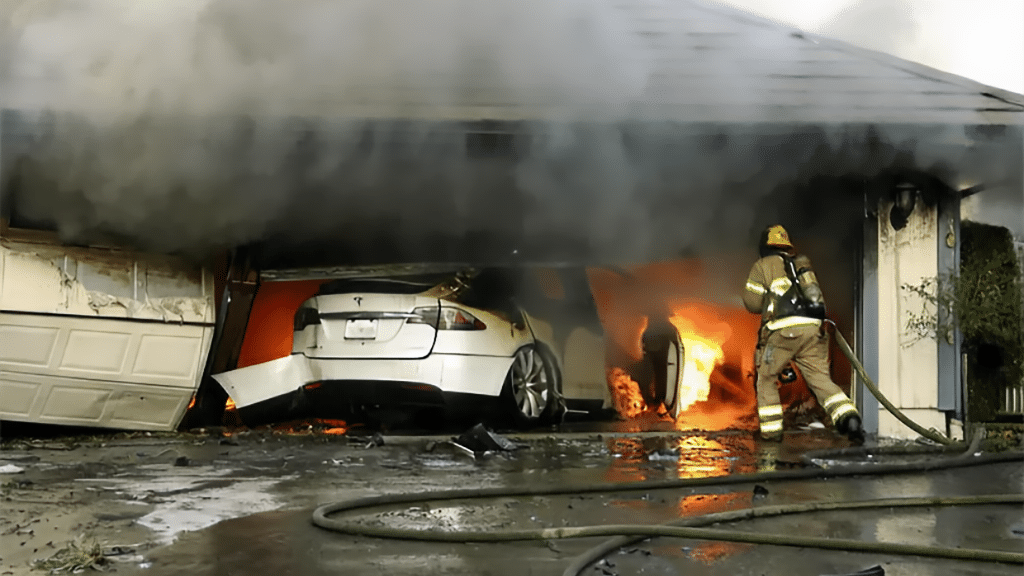Electric vehicle fires: Managing a new risk for hazmat teams with Blackline Safety
- April 26, 2024
- 10:44 am


Iain Hoey
Share this content
By Doug Mayer, Business Development, Fire Services Specialist, Blackline Safety
As electric vehicles (EVs) become increasingly popular in urban transportation—including e-bikes and e-scooters—the risk of EV battery fires poses new challenges for first responders. These fires can be difficult to extinguish and may emit hazardous gases, necessitating specialized equipment and strategies for effective management.
In responding to EV battery fires, connected multi-gas detectors have emerged as a game-changer. These devices leverage cloud-connectivity, location technology, customizable gas cartridges, and advanced analytics. The result is enhanced situational awareness, improved response times, and comprehensive gas detection to get ahead of risk and prevent EV fires from escalating.
Usage of EVs continues to grow exponentially. So do the risks to first responders.
Unexpected, long-lasting hazardous off-gases
EVs batteries, primarily lithium-ion, can catch fire and produce gases such as hydrogen fluoride (HF), which are not normally encountered during combustion engine fires. Once a lithium-ion battery catches fire, it can be difficult to extinguish and can continue burning, generating hazardous off gases for several hours. It can even reignite after being put out.
Responding to EV battery fires requires connected gas detection equipment to ensure the safety of both responders and communities. Traditional gas detectors may not be sufficient for detecting the unique hazards associated with EV fires, emphasizing the need for advanced sensors such as lower-explosive-limit molecular property spectrometers (LEL-MPS), HF sensors, oxygen (O2) sensors, and carbon monoxide (CO) sensors.
“This is a new hazard not seen in the industry to date and fire hazmat teams right now run the risk of not having the right gas detection equipment to properly protect them,” said Travis Rebello, Firefighter / HazMat Technician
“Knowing what gases are present allows us to make quick decisions that put their safety—and the safety of communities—first.”
Early detection critical
In EVs, where the presence of volatile, potential ignition substances such as fuel or battery electrolytes can escalate a fire incident. Gas detectors with LEL-MPS sensors can provide early warnings by detecting flammable gases, like hydrogen and methane, and trigger an alarm, allowing responders to take immediate action to prevent further escalation. CO is also generated during heating and fire, providing pre-warning of a potential thermal runaway (i.e. when an incident occurs where one exothermal process triggers other processes, finally resulting in an uncontrollable increase in temperature).
Proactively monitor risk
If an EV battery is at risk of thermal runaway, it needs to be transported to a storage location or facility where gas levels can be continuously monitored to ensure they remain within a safe threshold. Connected area monitors are ideal for this situation. They can be set up where the batteries are being stored and then gas levels can be continuously monitored from any remote location via an online dashboard. If gas levels rise above a set threshold, alarm notifications will be sent so that a response team can quell the situation before a fire occurs. And with a 100+ day battery life the portable area monitor can ensure the safety of the batteries’ storage for an extended period.
“Equipment that can detect precursor gases from battery failures is critical to being proactive in reducing the impact of EV fires,” said Bobby Salvesen, co-host of The Haz Mat Guys Podcast.
“Having the ability to directly measure potential gases present will allow members to know whether a situation is in the process of runaway or propagation or not.”
Managing the response
As an EV fire unfolds, O2 sensors can identify oxygen-depleted or oxygen-enriched environments, which can significantly impact the spread and severity of a fire. O2 sensors can assist in evaluating the effectiveness of fire suppression systems, ensuring a safe environment for responders and civilians.
Also critical are HF sensors, specifically designed to detect these hazardous substances not normally encountered in other combustion engine fires.
“HF is a toxic and corrosive gas that poses severe health risks to both humans and the environment” said Salvesen.
“By integrating HF sensors into gas detection solutions, responders can quickly identify and mitigate the risks associated with HF gas, enhancing their safety and the effectiveness of fire response efforts.”
Flexible equipment for the situation
Given the multiple gas hazards present in EV fires, gas detection equipment that enables multiple sensor combinations and hot swappable cartridges offers the best protection, allowing first responders to quickly adapt to the situation on scene.
“Your standard 4 gas meter may not give you the whole picture in a battery event. A meter that has a different sensor configuration to measure flammability and the presence of these specific toxic gases will go a long way to ensuring members’ safety,” added Salvesen.
For example, Blackline Safety’s G7 wearable connected multi-gas detectors can detect up to five gases simultaneously (with a portfolio of up to 20 gases to choose from) with swappable cartridges that can be configured to match the situation or address evolving needs.
Real-time visibility, reliable connectivity
Cloud-connected equipment allows incident commanders to see what is happening in real-time—even from a remote command center —so they can make data-informed safety decisions.
For example, instant alerts and notifications of location-stamped gas readings let incident commanders know exactly where gases are present and which personnel are at risk, allowing them to make decisions on where to direct responders and to take immediate action to prevent further escalation.
Data-informed incident management
Connected safety solutions advance EV fire response by providing real-time gas level insights, personnel location information and early toxic and flammable substance detection. This data empowers incident commanders to make informed decisions on evacuation routes and resource allocation.
Gas detectors with LEL-MPS, O2, CO, and HF sensors are crucial as they offer early warning capabilities and enable rapid response to potential fire hazards. They ensure prompt identification of flammable gases, oxygen levels and toxic substances, thereby preventing fire escalation and safeguarding lives.

